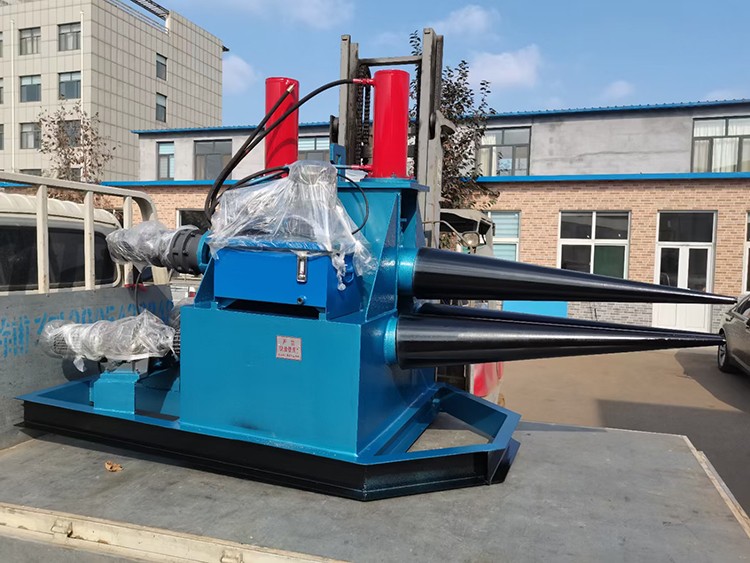With over 10 years of experience in manufacturing cone rolling machines, we have grown into a professional manufacturer. Today, we would like to introduce the key points of training for cone rolling machine operators:
As a key piece of equipment for metal sheet forming, the skill level of cone rolling machine operators directly affects product quality and production efficiency. Given the unique nature of the roll forming process, training should focus on four core modules: Equipment operation, process control, safety standards, and fault handling, to establish a systematic capability development framework.
1. Equipment structure and basic operations
Understanding mechanical systems
Understand the working principle of the roller shaft adjustment mechanism and the relationship between the upper roller inclination and taper angle.
Be familiar with the functional settings of the hydraulic system pressure valve and synchronous valve, and understand the warning threshold for pressure exceeding the limit.
Control panel operations
Be able to independently complete the input of CNC system parameters, including basic variables such as sheet thickness, taper ratio, and feed speed.
Understand the applicable scenarios for “progressive bending” and “segment compensation” modes, e.g., the former is used for thin-walled cones, while the latter is suitable for high-strength steel materials.
Fixture usage
Correctly install the guide rails and side pushers to ensure that the offset does not exceed 2 mm when feeding the sheet metal.
Master the quick mold change process, controlling the entire process from disassembly to repositioning within 15 minutes.
2. Process parameter setting and adjustment
Taper forming control
Calculate the initial roll axis angle based on material properties: set to a taper of 1:5 for low-carbon steel, and add a 15% compensation for stainless steel.
When performing multiple passes, adjust the angle by no more than 30% of the total angle each time to avoid local over-deformation.
Speed-pressure matching
Conventional carbon steel uses a “low-speed, high-pressure” strategy (6 m/min, 25 MPa), while aluminum alloys use a “high-speed, low-pressure” strategy (10 m/min, 18 MPa).
Real-time monitoring of motor load rate; if it exceeds 85% of the rated value, immediately reduce the feed speed.
Defect prediction and correction
Identify common defect characteristics: End warping indicates insufficient pressure, and a barrel shape indicates deviation in roller shaft parallelism.
Master online adjustment methods; if the cone generatrix is not straight, first check the horizontal calibration status of the lower roller.
3. Safety production and quality control
Risk prevention and control key points
When the thickness of the sheet material exceeds 12 mm, anti-rebound supports must be used, and operators are prohibited from standing within the rotating plane of the workpiece.
Under hot rolling conditions, the distance between the temperature measurement point and the operating platform must be no less than 1.5 meters, and heat-resistant gloves must be capable of withstanding temperatures above 300°C.
Process inspection standards
Mandatory inspection items for the first piece: Cone large-end diameter tolerance ±0.8 mm, generatrix straightness 0.5 mm/m.
Sampling frequency: Measure wall thickness reduction rate once every 10 pieces; carbon steel controlled within 8%, stainless steel not exceeding 12%.
Equipment maintenance schedule
Check the hydraulic oil level during daily shift handover. Replace immediately if turbidity exceeds the standard.
Use a laser calibration instrument to check the parallelism of the roller shafts weekly. If the cumulative error exceeds 0.1 mm/m, professional calibration is required.
4. Typical fault diagnosis and treatment
System alarm response
“Hydraulic Asynchronous” Alarm: First check whether the oil circuit filter is blocked, then test the proportional valve response curve.
“Servo overload” alarm: Check whether it is caused by a jammed mold, and do not reset the alarm three times in a row.
Mechanical abnormalities
Abnormal noise from the roller shaft: Stop the machine immediately and check the lubrication status of the bearings. When replenishing lithium-based grease, ensure that the old grease is completely removed.
Workpiece slippage: Clean oil stains on the roller surface with acetone. If necessary, roll anti-slip grooves with a depth of 0.1-0.3 mm.
Process Abnormality Analysis
Cone misalignment: Adjust the side guide plate pressure to 0.3-0.5MPa and check whether the burrs on the sheet metal have been cleaned.
Angle deviation: Recheck the taper calculation formula of the CNC system and confirm whether the equal thickness mode has been used incorrectly.
5. Skill advancement path
Simulation training system application
Practice complex cone processing through virtual reality (VR) equipment and become familiar with multi-curvature composite molding parameter settings.
Special materials training
Titanium alloy roll cones require additional preheating fixture operation training and mastery of infrared thermometer usage standards.
Cross-functional collaboration skills
Collaborate with process design personnel to reverse-engineer the optimal machining route based on drawings.
Improving roll forming machine operation skills is an ongoing process of integrating theoretical knowledge with practical experience. Establishing a closed-loop learning mechanism of “operation-recording-improvement,” supplemented by regular assessments, ensures that personnel capabilities evolve in tandem with production requirements. As intelligent inspection equipment becomes more widespread, future operating interfaces will integrate more real-time guidance functions; however, core process judgment capabilities will still rely on the accumulation of human experience.
If you are interested in cone rolling machines, please contact us.



 Address:Room 1202, Detaitang Building, No. 118 Huaguang Road, Zhangdian District, Zibo, Shandong
Address:Room 1202, Detaitang Building, No. 118 Huaguang Road, Zhangdian District, Zibo, Shandong WhatsApp:+8615653328535
WhatsApp:+8615653328535 Wechat: +8615965331535
Wechat: +8615965331535  E-mail:zs@sdsmachinery.com
E-mail:zs@sdsmachinery.com